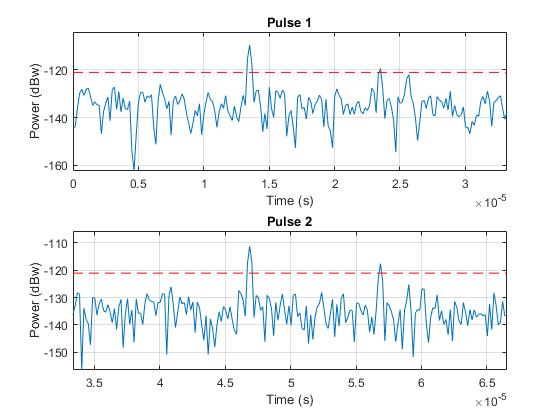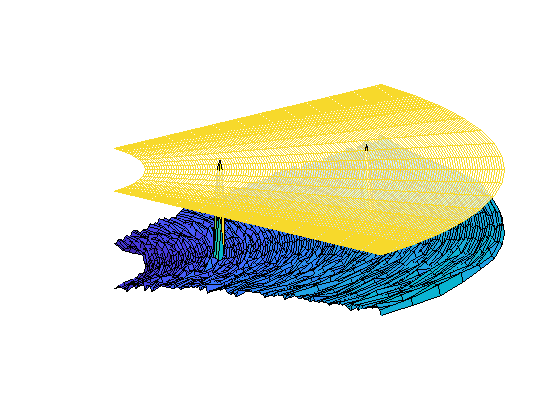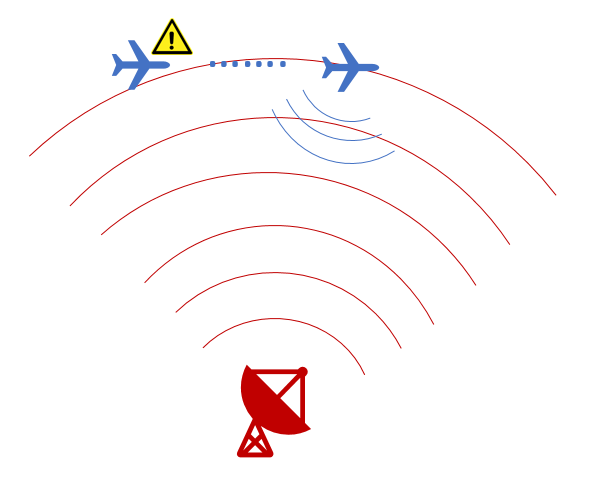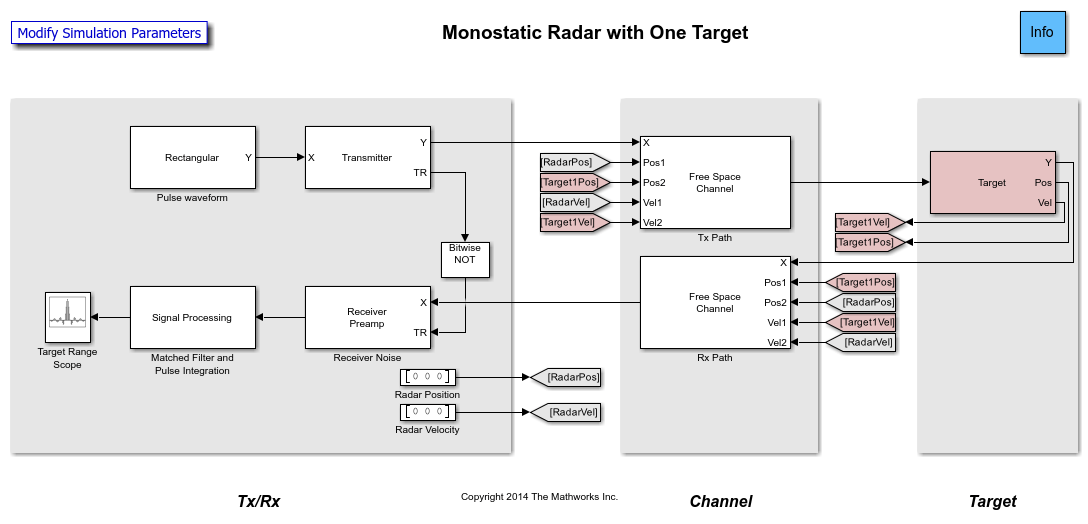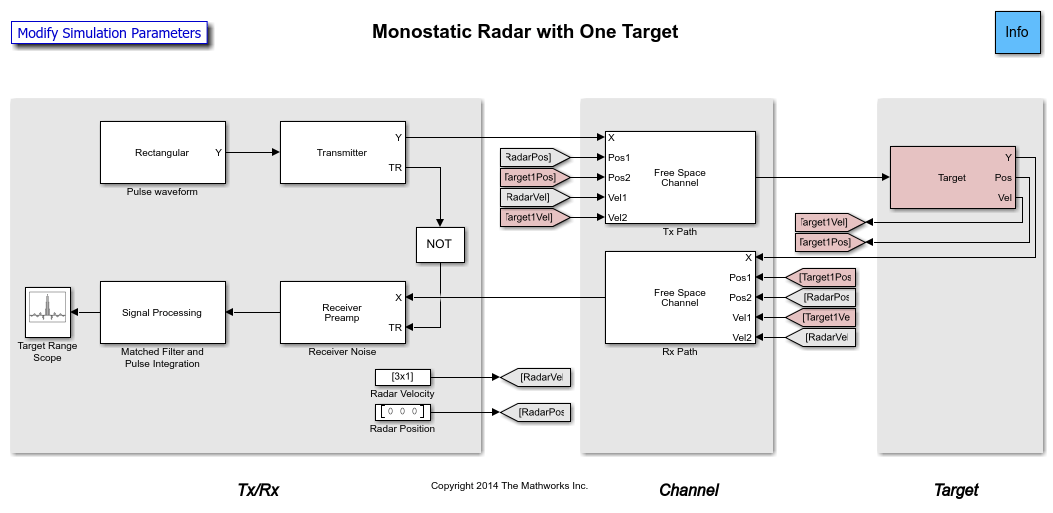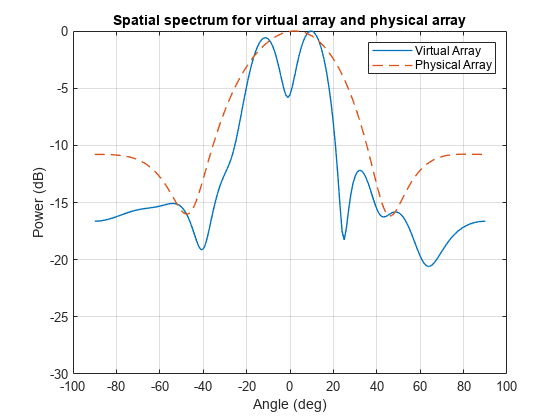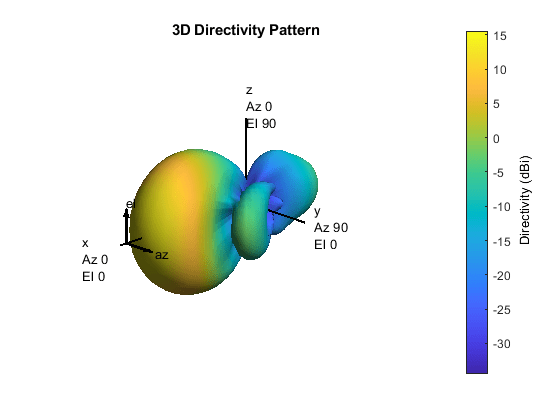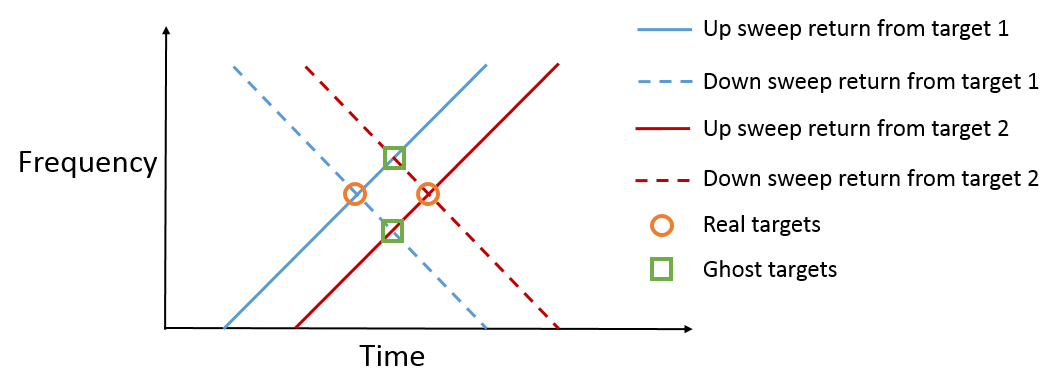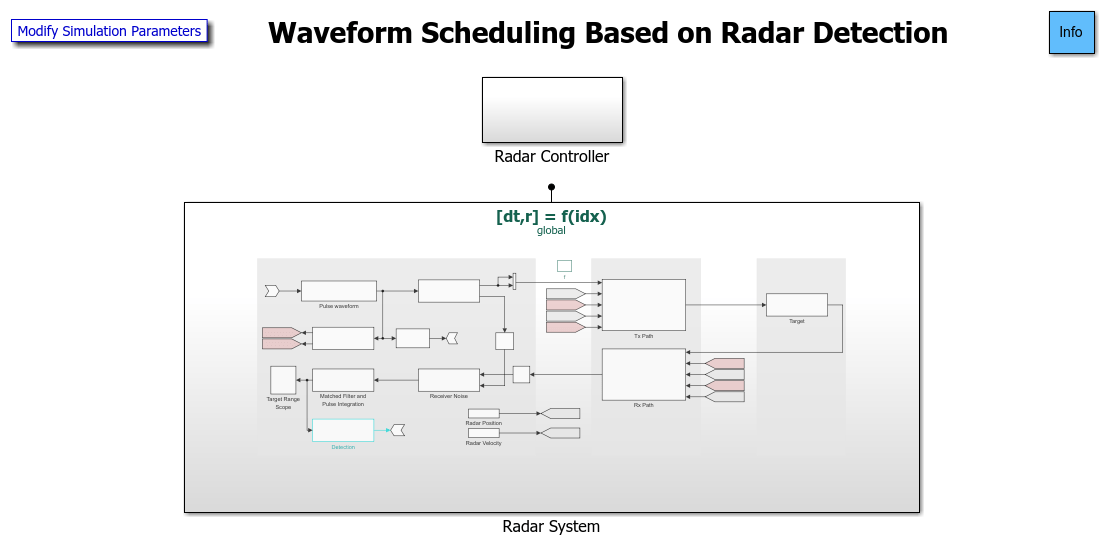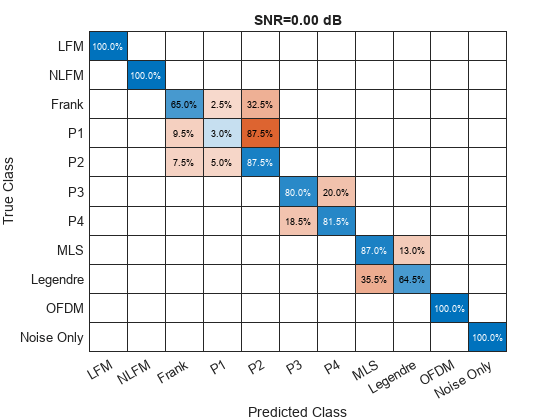Radar and EW Systems
This section contains applications of the toolbox to radar and electronic warfare (EW) systems. Some examples include:
Build an end-to-end radar system.
Design a moving target indication radar.
Model radar frequency agility to counter jamming and interference.
Estimate the parameters of a returned signal to improve localization of a target.
Simulate radar hardware, signal processing, and a propagation environment for a driving scenario. Model the vehicle motion and track the synthetic vehicle detections using Automated Driving Toolbox™.
Featured Examples
Simulating Test Signals for a Radar Receiver
Simulate received signal of a monostatic pulse radar to estimate the target range. A monostatic radar has the transmitter collocated with the receiver. The transmitter generates a pulse which hits the target and produces an echo received by the receiver. By measuring the location of the echoes in time, we can estimate the range of a target.
Electronic Scanning Using a Uniform Rectangular Array
Simulates a phased array radar that periodically scans a predefined surveillance region. A 900-element rectangular array is used in this monostatic radar. Steps are introduced to derive the radar parameters according to specifications. After synthesizing the received pulses, detection and range estimation are performed. Finally, Doppler estimation is used to obtain the speed of each target.
Waveform Parameter Extraction from Received Pulse
Modern aircraft often carry a radar warning receiver (RWR) with them. The RWR detects the radar emission and warns the pilot when the radar signal shines on the aircraft. An RWR can not only detect the radar emission, but also analyze the intercepted signal and catalog what kind of radar is the signal coming from. This example shows how an RWR can estimate the parameters of the intercepted pulse. The example simulates a scenario with a ground surveillance radar (emitter) and a flying aircraft (target) equipped with an RWR. The RWR intercepts radar signals, extracts the waveform parameters from the intercepted pulse, and estimates the location of the emitter. The extracted parameters can be utilized by the aircraft to take counter-measures.
Scene Visualization for Phased Array System Simulation
Use scenario viewer to visualize a system level simulation.
Waveform Design to Improve Range Performance of an Existing System
How waveform type affects a radar system's detection performance. The example considers the situation where a new performance goal is set for an existing radar system design. Since the old design can no longer achieve the desired performance, a new waveform is adopted. The example also shows how to model Swerling targets, simulate the return, and then detect the target ranges.
Simulating Test Signals for a Radar Receiver in Simulink
Model an end-to-end monostatic radar using Simulink®. A monostatic radar consists of a transmitter colocated with a receiver. The transmitter generates a pulse which hits the target and produces an echo received by the receiver. By measuring the time location of the echoes, you can estimate the range of the target. The first part of this example demonstrates how to detect the range of a single target using the equivalent of a single element antenna. The second part of the example will show how to build a monostatic radar with a 4-element uniform linear array (ULA) that detects the range of 4 targets.
Modeling RF Front End in Radar System Simulation
In a radar system, the RF front end often plays an important role in defining the system performance. For example, because the RF front end is the first section in the receiver chain, the design of its low noise amplifier is critical to achieving the desired signal to noise ratio (SNR). This example shows how to incorporate RF front end behavior into an existing radar system design.
Increasing Angular Resolution with Virtual Arrays
Introduces how forming a virtual array in MIMO radars can help increase angular resolution. It shows how to simulate a coherent MIMO radar signal processing chain using Phased Array System Toolbox™.
Patch Antenna Array for FMCW Radar
Model a 77 GHz antenna array for frequency-modulated continuous-wave (FMCW) radar applications. The presence of antennas and antenna arrays in and around vehicles has become commonplace with the introduction of wireless collision detection, collision avoidance, and lane departure warning systems. The two frequency bands considered for such systems are centered around 24 GHz and 77 GHz, respectively. In this example, we will investigate the microstrip patch antenna as a phased array radiator. The dielectric substrate is air.
Simultaneous Range and Speed Estimation Using MFSK Waveform
Compares triangle sweep frequency-modulated continuous (FMCW) and multiple frequency-shift keying (MFSK) waveforms used for simultaneous range and speed estimation for multiple targets. The MFSK waveform is specifically designed for automotive radar systems used in advanced driver assistance systems (ADAS). It is particularly appealing in multitarget scenarios because it does not introduce ghost targets.
Waveform Scheduling Based on Target Detection
In radar operation, it is often necessary to adjust the operation mode based on the target return. This example shows how to model a radar that changes its pulse repetition frequency (PRF) based on the radar detection.
LPI Radar Waveform Classification Using Time-Frequency CNN
Train a time-frequency convolutional neural network (CNN) to classify received radar waveforms based on their modulation scheme.
Radar Design from Radar Equation to RF Components
Model radars at increasing levels of fidelity using Radar Designer, radar budget plot, and transmitters and receivers.
MATLAB Command
You clicked a link that corresponds to this MATLAB command:
Run the command by entering it in the MATLAB Command Window. Web browsers do not support MATLAB commands.

Select a Web Site
Choose a web site to get translated content where available and see local events and offers. Based on your location, we recommend that you select: .
You can also select a web site from the following list
How to Get Best Site Performance
Select the China site (in Chinese or English) for best site performance. Other MathWorks country sites are not optimized for visits from your location.
Americas
- América Latina (Español)
- Canada (English)
- United States (English)
Europe
- Belgium (English)
- Denmark (English)
- Deutschland (Deutsch)
- España (Español)
- Finland (English)
- France (Français)
- Ireland (English)
- Italia (Italiano)
- Luxembourg (English)
- Netherlands (English)
- Norway (English)
- Österreich (Deutsch)
- Portugal (English)
- Sweden (English)
- Switzerland
- United Kingdom (English)
Asia Pacific
- Australia (English)
- India (English)
- New Zealand (English)
- 中国
- 日本Japanese (日本語)
- 한국Korean (한국어)
